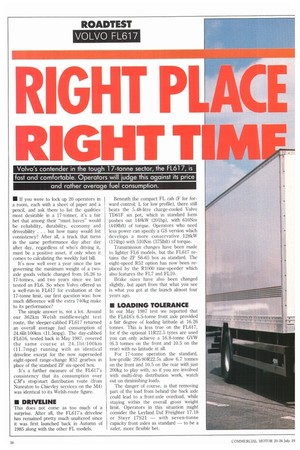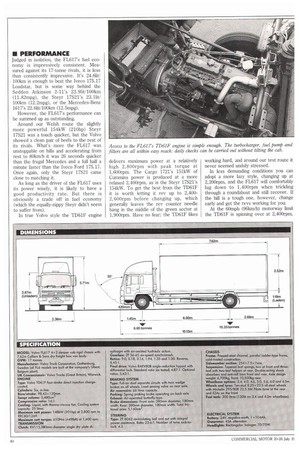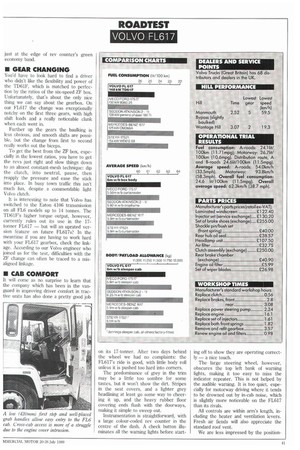RIGHT Pt CE
Page 40

Page 42

Page 43

If you've noticed an error in this article please click here to report it so we can fix it.
GIIIT T
Volvo's contender in the tough 17-tonne sector, the FL617, is fast and comfortable. Operators will judge this against its price and rather average fuel consumption.
• If you were to lock up 20 operators in a room, each with a sheet of paper and a pencil, and ask them to list the qualities most desirable in a 17-tonner, it's a fair bet that among their "must haves" would be reliability, durability, economy and driveability . . . but how many would list consistency? After all, a truck that turns in the same performance day after day after day, regardless of who's driving it, must be a positive asset, if only when it comes to calculating the weekly fuel bill.
It's now well over a year since the law governing the maximum weight of a two axle goods vehicle changed from 16.26 to 17-tonnes, and two years since we last tested an FL6. So when Volvo offered us a well-run-in FL617 for evaluation at the 17-tonne limit, our first question was: how much difference will the extra 740kg make to its performance?
The simple answer is, not a lot. Around our 362km Welsh middleweight test route, the sleeper-cabbed FL617 returned an overall average fuel consumption of 24.6lit/100km (11.5mpg). The day-cabbed FL616, tested back in May 1987, covered the same course at 24.1lit/100km (11.7mpg) running with an identical driveline except for the now superseded eight-speed range-change R52 gearbox in place of the standard ZF six-speed box.
It's a further measure of the FL617's consistency that its consumption over
CM's stop/start distribution route (from Nuneaton to Chievley services on the M4) was identical to its Welsh-route figure.
• DRIVELINE
This does not conic as too much of a surprise. After all, the FL617's driveline has remained pretty much unaltered since it was first launched back in Autumn of 1985 along with the other FL models. Beneath the compact FL cab (F for forward control; L for low profile), there still beats the 5.48-litre charge-cooled Volvo TD61F six pot, which in standard form pushes out 148kW (201hp), with 610Nm (449lbft) of torque. Operators who need less power can specify a GS version which develops a more conservative 128kW (174hp) with 510Nm (375Ibft) of torque.
Transmission changes have been made to lighter FL6 models, but the FL617 retains the ZF S6-65 box as standard. The eight-speed R52 option has now been replaced by the R1000 nine-speeder which also features the FL7 and FL10.
Brake sizes have also been changed slightly, but apart from that what you see is what you got at the launch almost four years ago.
• LOADING TOLERANCE
In our May 1987 test we reported that the FL616's 6.5-tonne front axle provided a fair degree of loading latitude at 16.26 tonnes. This is less true on the FL617, for if the optional 11R22.5 tyres are used you can only achieve a 16.8-tonne GVW (6.3 tonnes on the front and 10.5 on the rear) with no latitude at all.
For 17-tonne operation the standard, low-profile 295/80R22. 5s allow 6.7 tonnes on the front and 10.5 on the rear with just 200kg to play with, so if you are involved with multi-drop distribution work, watch out on diminishing loads.
The danger of course, is that removing part of the load from behind the back axle could lead to a front-axle overload, while staying within the overall gross weight limit. Operators in this situation might consider the Leyland Daf Freighter 17.18 or Steyr 17521 — with seven-tonne capacity front axles as standard — to be a safer, more flexible bet.
• PERFORMANCE
Judged in isolation, the FL617's fuel economy is impressively consistent. Measured against its 17-tonne rivals, it is less than consistently impressive. It's 24.61iti 100km is enough to beat the Iveco 175.17 Loadstar, but is some way behind the Seddon Atkinson 2-11's 23.91it/100km (11.82mpg), the Steyr 17S21s 23.11it/ 100lun (12.2mpg), or the Mercedes-Benz 1617's 22.6lit/100km (12.5mpg).
However, the FL617's performance can be summed up as outstanding.
Around our Welsh route the slightly more powerful 154kW (210hp) Steyr 17521 was a touch quicker, but the Volvo showed a clean pair of heels to the rest of its rivals. What's more the 1.1617 was unstoppable on hills and accelerating from rest to 80km/h it was 26 seconds quicker than the frugal Mercedes and a full half a minute faster than the Iveco Ford 175.17. Once again, only the Steyr 17S21 came close to matching it.
As long as the driver of the FL617 uses its power wisely, it is likely to have a good productivity rate. But there is obviously a trade off in fuel economy (which the equally-nippy Steyr didn't seem to suffer from).
In true Volvo style the TD61F engine delivers maximum power at a relatively high 2,800rpm with peak torque at 1,600rpm. The Cargo 1721's 151kW of Cummins power is produced at a more relaxed 2,400rpm, as is the Steyr 17521s 154kW. To get the best from the TD61F it is worth letting it rev up to 2,4002,60Orpm before changing up, which generally leaves the rev counter needle bang in the middle of the green sector at 1,900rpm. Have no fear; the TD61F likes working hard, and around our test route it never seemed unduly stressed.
In less demanding conditions you can adopt a more lazy style, changing up at 2,200rpm, and the FL617 will comfortably lug down to 1,400rpm when trickling through a roundabout and still recover. If the hill is a tough one, however, change early and get the revs working for you.
At the 60mph (96km/h) motorway limit the TD61F is spinning over at 2,400rpm, just at the edge of rev counter's green economy band.
• GEAR CHANGING
You'd have to look hard to find a driver who didn't like the flexibility and power of the TD61F, which is matched to perfection by the ratios of the six-speed ZF box. Unfortunately, that's about the only nice thing we can say about the gearbox. On our FL617 the change was exceptionally notchy on the first three gears, with high shift loads and a really noticeable clunk when each went in.
Further up the gears the baulking is less obvious, and smooth shifts are possible, but the change from first to second really works out the biceps.
To get the best from the ZF box, especially in the lowest ratios, you have to get the revs just right and slow things down to an almost constant-mesh technique: dip the clutch, into neutral, pause, then reapply the pressure and ease the stick into place. In busy town traffic this isn't much fun, despite a commendable light Volvo clutch.
It. is interesting to note that Volvo has switched to the Eaton 4106 transmission on all FL6 models up to 14 tonnes. The TO61F's higher torque output, however, currently rules out its use in the 17tonner FL617 but will an uprated version feature on future FL617s? In the meantime if you are having to work hard with your FL617 gearbox, check the linkage. According to our Volvo engineer who joined us for the test, difficulties with the ZF change can often be traced to a misaligned linkage.
• CAB COMFORT
It will come as no surprise to learn that the company which has been in the vanguard in improving driver comfort in tractive units has also done a pretty good job on its 17-tonner. After two days behind the wheel we had no complaints: the FL617's ride is good, with little body roll unless it is pushed too hard into corners.
The predominance of grey in the trim may be a little too sombre for some tastes, but it won't show the dirt. Stripes in the seat covers, and a lighter grey headlining at least go some way to cheering it up, and the heavy rubber floor covering ends flush with the doorways, making it simple to sweep out.
Instrumentation is straightforward, with a large colour-coded rev counter in the centre of the dash. A check button illuminates all the warning lights before start ing off to show they are operating correctly a nice touch.
The large steering wheel, however, obscures the top left bank of warning lights, making it too easy to miss the indicator repeater. This is not helped by the audible warning. It is too quiet, especially for motorway driving where it tends to be drowned out by in-cab noise, which is slightly more noticeable on the FL617 than its rivals.
All controls are within arm's length, including the heater and ventilation levers. Fresh air fiends will also appreciate the standard roof vent.
We are less impressed by the position








































































































































